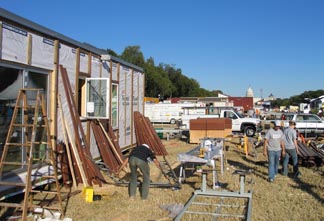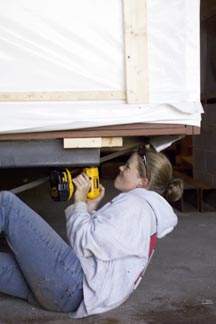Seeking a place in the sun, Cornell's solar house arrives in D.C. for Oct. 7-14 international competition
By Susan Lang


The little solar house -- only 800 square feet but valued at $350,000 -- stripped and shrouded in plastic, has finally hit the road, delayed seven days because an axle broke under the trailer holding the 30,000-pound house when it first tried to pull out of its Cornell University driveway last Wednesday.
After much deliberation, it was decided that even stronger axles would not solve the problem. The student team, with help from Cornell professors and industry experts, decided on a new course of action. The past seven days have been spent developing a way to jack the house up five feet, remove the entire steel chassis from under the house, add a new support structure and lower the house onto an industrial flatbed capable of carrying up to 100,000 pounds. With this new plan, the house was finally able to leave Ithaca Sept. 28.
The house arrived in Washington, D.C., on the evening of Sept. 28 with no further problems and was positioned on the National Mall. Over the next few days the team will set up the house in preparation for the competition.
Researched, designed, funded and planned by Cornell students over the past 2.5 years and built this summer on wheels, the fully functional, self-sufficient, solar-powered 16-by-40-foot house was stripped and braced -- including its handmade kitchen cabinets -- for the trip to Washington, D.C. Once there, the student team will take a week to put it all back together again for the U.S. Department of Energy's (DOE) international 2005 Solar Decathlon, where Cornell will compete against 17 other collegiate teams, Oct. 7 to 14.
These past few weeks have been hectic for the team -- the washing machine didn't work properly even though it was brand new, an accident involving high voltage and heavy steel was just barely avoided, and one of the 14 evacuation tubes needed to heat water on the roof fell to the ground and shattered.
"There have been other snags here and there but nothing we can't handle," said Tim Fu, Engineering '05, one of the major forces behind the project from its beginning and now a heating and air conditioning consultant for commercial buildings in New York City. "It's turning out wonderfully."
Following the house out of town are a flatbed truck with metal frames for the polyvinyl canopy to house the photovoltaics on the roof and extensive landscaping and a tractor-trailer holding the battery enclosures, grey water filtration system, student-made furniture and electric car. Also en route to Washington is a separate truck carrying 8,000 pounds of batteries. The batteries are capable of storing enough energy to power the house for well over a week.
Following the trucks will be a trail of students staggering their arrivals. They will work on the house on the National Mall, where the students will run tests for a week before the competition begins.
Throughout the house's monthlong stay in Washington, more than 40 students will come and go -- with about a dozen at any one time -- for up to a week or two each, even though they will miss classes.
"It's an extreme challenge for us," admitted Hilary Corsun, a senior double-majoring in applied economics and management and animal science, who serves as the primary business contact in the Solar Decathlon's office. "A lot of the professors seem to be quite forgiving for missing classes, and a lot of the students planned ahead by taking a lighter course load this semester so that they could afford to miss some classes."

To save on costs -- the student team has $80,000 in Cornell loans for the building to pay off -- students will stay at the home of Fu's parents in Arlington, Va. To recoup some money, they'll be selling $10 T-shirts with the slogan "Ithaca is Sunny" in Ithaca and Washington.
The DOE competition involves designing and building an 800-square-foot sustainable house that derives all its power from the sun. The houses will be evaluated on criteria ranging from power acquisition and storage and everyday performance to advocating the use of household solar power to potential users. In addition to designing and building the home, decathlon teams also participate in 10 contests during the competition week in which the houses will be judged on such criteria as comfort and how well they perform in providing energy for heating and cooling, hot water, lighting and appliances.
Cornell's house, the only submission from an Ivy League school, will compete against houses valued at up to $1 million, three times that of the Cornell house.
"It would have been easier if we didn't have to fund-raise so much -- some of our competitors were almost entirely funded by their schools -- but I don't think the differences in value will hurt us," said Corsun. "Even if we had more money, we would have used the same designs, as one of our goals was to design a house that would appeal to the public and still be affordable."
Fu and nine other undergraduates submitted a proposal in 2003 to the DOE, which accepted the proposal and gave the team $5,000 in seed money. Since then, the team has recruited dozens of students to participate, including fund raising and soliciting product donations from several dozen companies. The entirely student-run project also has received funding from Cornell's Colleges of Engineering; Architecture, Art and Planning; and Agriculture and Life Sciences.
Media Contact
Get Cornell news delivered right to your inbox.
Subscribe